हिपोक्रेतिज्
| हिपोक्रेतिज् कोसमि (प्राचीन यवन: Ἱπποκράτης) | |
|---|---|
 Engraving by Peter Paul Rubens, 1638, courtesy of the National Library of Medicine.[१] | |
| बूगु | करिब ४६० इ पू कोस, यवन |
| मदूगु | करिब ३७० इ पू लारिसा, यवन |
| ज्या | चिकित्सक |
हिपोक्रेतिज् कोसमि (यवन: Ἱπποκράτης, आइपिए उच्चारण:hɪˈpɒkrəˌtiːz, करिब ४६० इपू – करिब ३७० इपू); पेरिकल्सया युगया छम्ह प्राचीन युनानी चिकित्सक ख। वय्कःयात चिकित्साया इतिहासया दक्ले विलक्षण व्यक्तित्वय् छम्हया कथं नालेगु या। वय्कःयात चिकित्साया अबुया कथं नं नालेगु या। [२] [३] [४] वय्कःया बौद्धिक स्कुलं प्राचीन यवनया चिकित्साय् हिउपा हल। वय्कःया स्कुलं चिकित्सायात छगू निश्चित विधाया रुपय् पलिस्था यात व थुकियात विचाः व चिन्तनं सीमांकृत यात। थ्व कथं वय्कलं चिकित्सायात छगू बौद्धिक व्यवसाय दयेकादिल। [५][६]
वय्कःया च्वसु व वय्कः धुंकाया वय्कःया पद्धति छ्यलिपिं चिकित्सकतयेगु च्वसु ल्वाकज्या। थुकियात मंका कथं हिपोक्र्याटिक ग्रन्थ धाइगु या। च्वसु ल्वाकज्यागुलिं वय्कःया चिकित्सा सम्बन्धि विचा, वय्कःया व्यक्तिगत अनुभूति आदि थें न्याःगु वय्कःया चिकित्सा जीवनया पक्ष धाःसा प्रस्ट मजु। अथेजुसां, हिपोक्रेतिज्यात प्राचीन चिकित्साया सर्वोच्च चिकित्सकया रुपय् नालेगु या। निश्चित कथं वय्कःयात क्लिनिकल चिकित्साया व्यवस्थापित अध्ययनया निंतिं, वय्कः स्वया न्हापा चिकित्साया ज्ञानया सार दयेकेत व चिकित्सकतयेगु सपथ हिपोक्र्याटिक ओथ आदिया निंतिं लुमंकिगु या। [५] [७]
जीवनी
[सम्पादन]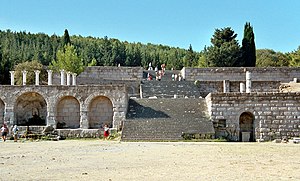
इतिहासकारकथं हिपोक्रेतिज्या जन्म करिब ४६० इपूइ यवनी टापू कोसय् जूगु ख। वय्कः छम्ह नांजाम्ह चिकित्सक व चिकित्साया गुरु जुयादिल। वय्कःया बारेय् यक्व जनश्रुतित दु। थन्यागु सकल जनश्रुति पाय्छि मजुइफु यक्व सम्भावना दु। [८] इफेसनसया सोरानस, छम्ह २गु शताब्दीया यवन गाइनेकोलोजिस्ट, [९] वय्कःया न्हापांम्ह बायोग्राफर ख। हिपोक्रेतिज्या मानवीय रुपया जानकारीया प्रमुख स्रोत वय्कः हे ख। हिपोक्रेतिज्या बारेय् एरिस्टोटलया च्वसुइ नं उल्लेख जुगु दु। ४गु शताब्दी ईपूया सुदा निसें १०गु शताब्दी इसंतक्क व १२गु शताब्दीया जन Tzetzesया ज्याय् वय्कःया वर्णन लूगु दु। [५][१०]
सोरानसं(Soranus) च्वयादिगु दु कि हिप्पोक्रेतसया अबु हेराक्लिदेस् (Heraclides) छम्ह चिकित्सक ख व वय्कःया मा प्राक्सितेला (Praxitela) तिजान(Tizane)या म्ह्याय् ख। हिप्पोक्रेतसया निम्ह काय् थेसालस (Thessalus) व द्राको (Draco) व वय्कःया म्ह्याय् जिलाजं पोलिबस (Polybus) वय्कःया शिषय ख। प्रसिद्ध चिकित्सक ग्यालेन कथं पोलिबस हिप्पोक्रेतसया सच्चा उत्तराधिकारी ख, थेसालस व द्राको निम्हेसिनं हे थःगु छम्ह-छम्ह काय्या नां हिप्पोक्रेतस धका तल। [११][१२]
सोरानसं च्वयादिगु दु कि हिप्पोक्रेतसं चिकित्सा थःगु अबु व अजा नाप सीकादिल व मेमेगु विषय देमोक्रितस (Democritus) व गर्गियास (Gorgias) नाप सीकादिल। सम्भवतः, हिप्पोक्रेतसया दीक्षा कोसया इस्क्लेपियनय् जुल व थ्रेसियन (Thracian) चिकित्सक हेरोदिकस (Herodicus)या अधीनय् ब्वनादिल। वय्कःया समकालीन प्लेतोया दायलग प्रोतागोरास् (Protagoras)य् वय्कःयात "Hippocrates of Kos, the Asclepiad" धका वर्णन यानातःगु दु।[१३][१४] हिप्पोक्रेतसं थःगु सकल जीवनय् चिकित्साशास्त्रया अभ्यास व अध्यापन यानादिल, वय्कलं थुकिया निंतिं Thessaly, Thrace, व मार्मारा सागर (Sea of Marmara) तक्क थ्यनादिल। [१२] वय्कः सम्भवतः लारिसाय् (Larissa) मदयादिल। वय्कःया मृत्युया यक्व वर्णन दु, गनं वय्कः १००दँ स्वया अप्व तक्क म्वानादिल धका च्वयातःदु नं दु, तर वय्कः करिब ८३ वा ९०दँ तक्क म्वानादिल धैगु विज्ञतेगु मत दु। [१२]
हिप्पोक्रेटिक सिद्धान्त
[सम्पादन]"It is thus with regard divine nor more sacred than other diseases, but has a natural cause from the originates like other affections. Men regard its nature and cause as divine from ignorance and wonder..."
हिपोक्रेतिज्यात दैवी शक्ति, बाखं व आलौकिक प्रभावय् विश्वास मयाइम्ह म्हापांम्ह चिकित्सकया रुपय् नालेगु या। वय्कःयात पाइथागोरसया शिष्यतयेसं चिन्तन व चिकित्सा एकिकृतयाःगु श्रेय बियातःगु दु। [१६] वय्कलं चिकित्सायात धर्म स्वया पृथक तयादिल व ल्वेयात द्यःतयेगु श्राप मजुसें वातावरणीय प्रभाव, नसाः व प्राणीतयेगु अन्तरक्रियाया परिणामया रुपय् ब्वयादिल। सकल हिप्पोक्रेटिक ग्रन्थय् छगू नं थासय् दैवी शक्तिया वा दैवी ल्वेया वर्णन मदु। अथेजुसां व ईया विज्ञान आपालं विकास मजुगुलिं वय्कःया यक्व सिद्धान्त व विश्वास थौं वया पाय्छि मजूगु खनेदु। दसु- वय्कःया एनाटोमी व फिजियोलोजी, ह्युमोरिजमया सिद्धान्त आदि पाय्छि मजूगु प्रमाणित जुइ धुंकल। [१७][१८][१९]
प्राचीन यवन चिकित्सा ब्वंकुथि ल्वेयात निदान यायेगु पद्धतिइ निगु पुचः, निदियान (Knidian) व कोआन(Koan)य् विभक्त जूगु खनेदु। निदियान पुचः डायग्नोसिसय् अप्व केन्द्रित जूगु खनेदु। हिप्पोक्रेतसया ईलय् चिकित्सा सिक्क प्रारम्भिक अवस्थाय् दयाच्वन। तत्कालीन ग्रीक तजिलजिइ मनूया म्ह चायेकिगु वर्जित यानातःगुलि मनूया एनाटोमी व फिजियोलोजीया बारेय् सिक्क कम जक्क ज्ञान दयाच्वन। लक्षणात्मक निदान याइगु निदियन चिकित्सा (Knidian school)य् छगू हे ल्वचं छझ्वः लक्षण क्यने बिलय् अन्यागु लक्षणया कारक ल्वय् सीके मफयाच्वनिगु अवस्था दयाच्वन। [२०] कोसया हिप्पोक्रेतिक चिकित्सां धाःसा साधारण दायग्नोसिस व निष्क्रिय चिकित्साया पद्धतिं अप्व सफलता ल्हातय् लाकल। थ्व चिकित्सालयया केन्द्र ल्वमितेगु स्यहार व प्राग्ज्ञान (prognosis) जूगु व लक्षण वा सटीक दायग्नोसिस मजूगुलिं थ्व चिकित्सालयं ल्वय्तेत अप्व प्रभावकारी तरिकां ल्वय् लंकेफत व नापं निदानात्मक अभ्यास नं संस्थागत यायेफत।[२१][२२]
आधुनिक चिकित्साय् थीथी विकास नापं चिकित्सा हिप्पोक्रेतिक पद्धतिं नाइदियन पद्धतिइ (Knidian school) उन्मुख जुयाच्वंगु दु। ल्वय्या दायग्नोसिस आःसा चिकित्साया केन्द्रया रुपय् स्थापित दु। हिप्पोक्रेतसया चिकित्सा पद्धति मनूयात याउंक च्वनेबिया मनूया म्ह व प्रतिरोधात्मक प्रणालीं ल्वय् नाप ल्वायेत बल्लाकिगु ख। भिंगु वासः, न्हूगु प्रविधि व मनूया म्हया बारेय् सियावःगु ज्ञानं धाःसा म्हय् ल्वय् गन जुयाच्वंगु स्वया उकियात छकलं हे सिधेकेफइगु दक्षता हासिल यात। लिपांगु ईलय् हिप्पोक्रेतिक पद्धतिया यक्व प्रतिवाद वल व छम्ह फ्रेञ्च चिकित्सक एम् एस होदार्त (M. S. Houdart)जुं हिप्पोक्रेतिक पद्धतियात सीबिलय्या ध्यान (meditation upon death) धका तक्क धयादिल। [२३]
रसवाद (ह्युमरिजम) व संकट
[सम्पादन]हिप्पोक्रेतिक चिकित्सा कथं ल्वय् धाःगु म्हय् प्यता रस वा ति(humour)या प्राकृतिक मात्रा पेप्सिस(pepsis) स्यना जुइगु अवस्था ख। [२४] प्यता ति, हि, हाकूगु खाइ (black bile), म्हासुगु खाइ (yellow bile) व खइ वा कफ (phlegm)या संतुलन स्यना (दिस्क्रेसिया वा dyscrasia अर्थात मभिंगु मिश्रण) जुया मनूयात ल्वचं काइ व थ्व सन्तुलन लिहां मवइबिलय् तक्क मनूयात ल्वचं काया हे तइ। हिप्पोक्रेतसया चिकित्सापद्धति थ्व असंतुलनयात सन्तुलित यायेगु दिशाय् उन्मुख जूगु खनेदु, दसु साइत्रसयात कफ अप्वइबिलय् छ्यलिगु। [२५]
हिप्पोक्रेतिक चिकित्साया मेगु महत्त्वपूर्ण पक्ष संकट (crisis)या अवधारणा ख। थ्व चिकित्सा पद्धति अनुसार क्राइसिस वा संकट धाःगु थन्यागु बिन्दु ख गन थ्यनेधुंका या ल्वमि ल्वचं कया सीना वनि वा छुं प्राकृतिक प्रक्रियां ल्वमिया उसाँय् भिना ल्वमि लिहां वइ। छगू संकट धुंका हानं ल्वमियात ल्वचं कया यंकेफु, गुकियात रिल्याप्स (relapse) धाइ व थ्व धुंका निर्णायक संकट हानं वयेफु। हिप्पोक्रेतसया थ्व सिद्धान्त अनुसार संकट संकटात्मक दिं (critical days) खुनु जुइफु, थन्यागु संकटात्मक दिं ल्वय् नापं ल्वमिया न्हापांगु सम्पर्कया निश्चित ई धुंका जुइ धइगु हिप्पोक्रेतिक चिकित्सां विश्वास यानातल। छगू संकट संकटात्मक दिं स्वया तापाक्क जूसा रिल्याप्स जुइगु सम्भावना अप्वया वनि। ग्यालेनया विचारय् थ्व सिद्धान्त हिप्पोक्रेतसं प्रतिपादित यानादीगु ख, तर थ्व विचाः वय्कः स्वया न्ह्यः निसें हे दयाच्वंगु नं जुइफु।[२६]

हिप्पोक्रेतिक चिकित्सा साधारण, विनम्र और निष्क्रिय चिकित्सा ख। वय्कःया चिकित्सा पद्धति "प्रकृतिया लंकिगु शक्ति"इ ("लातिनय् vis medicatrix naturae") आधारित जुयाच्वन। थ्व सिद्धान्त अनुसार म्हय् प्यता ति (ह्युमर)यात संतुलनय् हयेगु शक्ति दु व थःमंतुं लनिगु शक्ति (physis) दु। [२४] हिप्पोक्रेतिक चिकित्साया केन्द्रविन्दु थ्व "प्राकृतिक प्रकृया"यात अपुइकिगु ख। हिप्पोक्रेतसया धारणाय् "आराम व स्थिरीकरण दकलय् महत्त्वपूर्ण जु" ( "rest and immobilization [were] of capital importance")। [२७] साधारण रुपय् हिप्पोक्रेतिक चिकित्साय् ल्वमियात दया क्यनिगु, सौम्य चिकित्सा यायेगु, व ल्वमियात सफा, सुग्घर तयेगुलि केन्द्रित जुल। दसुया निंतिं हिप्पोक्रेतिक चिकित्साय् घाःयात लंकेत घायात सुक्खा त्वतिगु वा घालय् लः वा अय्ला जक्क तयेगु या। स्यायेगु कम यायेत मलम म्हो जक्क छ्यलिगु या। [२८]
हिप्पोक्रेतसं अपुइक वासः मबीगु व विशेषज्ञ चिकित्सा स्वया साधारण दायग्नोसिस व सामान्य चिकित्साय् अप्व जोड बियादिल। [२८][२९] छुं अवस्थाय् धाःसा कडा वासः बीगु नं या। [३०] थ्व निष्क्रिय पद्धति साधारण ल्वय्, दसु ल्हा/तुति त्वधइगु अवस्थाय् प्रभावशाली खनेदु, गुकिलि त्राक्सन जक्क बिया ल्वय् लनि। थुकिया निंतिं हिप्पोक्रेतिक बेञ्च व मेमेगु ज्याभः छ्यलिगु या।
हिप्पोक्रेतिक चिकित्साया बल्लागु पक्ष थुकिया प्राग्ज्ञान(prognosis)य् जोड ख। हिप्पोक्रेतसया ईलय् चिकित्सा पद्धति सिक्क हे प्रारम्भिक अवस्थाय् दयाच्वंगुलिं चिकित्सकं यायेफूगु ज्या अप्व मदु। तर, चिकित्सकं ल्वय्यात आंकलन याना, न्हापाया समान ल्वय्या सूचंया आधारय्, ल्वचं लिपा पिकायेफूगु अवस्था पूर्वानूमान यायेगु ख। [१९][३१]
व्यवसायिकता
[सम्पादन]
हिप्पोक्रेतिक चिकित्सा थःगु व्यवसायिकता, अनुशासन व कठोर प्रयासया निंतिं नांजाः। [३३] हिप्पोक्र्यातिक ग्रन्थ चिकित्सकया बारेय्( On the Physician) दुने चिकित्सक धाम्ह न्ह्याबिलय् हे सफा, इमानदार, शान्त, सबुझ व गंभीर जुइमा धका च्वयातःगु दु। हिप्पोक्र्यातिक चिकित्सकं थःगु ज्याया सकल पक्षय् ध्यान बीगु या: थन्याम्ह चिकित्सकं प्राचीन शल्य क्वथाय् "मतो, मनू, ज्याभः, ल्वमि च्वनिगु पहः, व पट्टी व स्प्लिनतया पद्धति("lighting, personnel, instruments, positioning of the patient, and techniques of bandaging and splinting")या विस्तृत निर्देशन पालना या। [३४] He even kept his fingernails to a precise length.[३५]
हिप्पोक्रेतिक पाठशालां अवलोकन व प्रलेखनया नैदानिक सिद्धान्ततेत यक्व महत्त्व ब्यु। थ्व सिद्धान्त अनुसार छम्ह चिकित्सकं थःगु दक्वं अवलोकन व चिकित्सा पद्धतितेत सिक्क स्पष्ट व उद्देश्यीय पहलं संग्रह यायेमा, व थन्यागु संग्रहीत विवरण छम्ह चिकित्सकं मेम्ह चिकित्सकयात हस्तान्तरण याना मेम्ह चिकित्सकं छ्यलेछिंगु जुइमा।[३६] हिप्पोक्रेतसं थीथी लक्षण दसु रंग, नादि, ज्वरः, स्याइगु, चाल, उत्सर्जन आदिया नियमित, सचेत विवरण दयेकादिल। [३१] वय्कलं ल्वमिया ल्वय्या इतिहास कयाच्वंबिलय् ल्वमिया नादि स्वया ल्वमिं खःगु खँ ल्हागु दु कि मदु धका स्वयेगु यानादि धैगु मान्यता दु।[३७] हिप्पोक्रेतसं नैदानिक अवलोकन(clinical observations)तेत परिमार्जित याना पारिवारिक इतिहास व वातावरणयात नं तनादिल। [३८] "To him medicine owes the art of clinical inspection and observation".[१९] थ्व कारणया निंतिं वय्कःयात सम्भवतः नैदानिक चिकित्साया अबु ("Father of Clinical Medicine")या पदवी बियातःगु दु।[३९]
चिकित्साय् प्रत्यक्ष योगदान
[सम्पादन]
हिपोक्रेतिज् व वय्कःया चेलातयेसं यक्व ल्वेया दकले प्रारम्भिक वर्णन यानादिगु दु। वय्कःयात दकले न्ह्यः क्लबिङया वर्णनया श्रेय बियातःगु दु। थ्व अवस्था क्रोनिक सुपोरेटिभ लङ्ग दिजिज, सों क्यान्सर, व सायनोटिक हार्ट दिजिजय् खनेदु। थ्व कारणं क्लबिङयात हिप्पोक्र्याटिक पतिं नं धाइगु या। [४०] हिपोक्रेतिज् प्रोग्नोसिसय् हिप्पोक्रेटिक ख्वा वर्णन यानादिम्ह न्हापांम्ह चिकित्सक ख।
हिप्पोक्रेतसं ल्वय्तेत एक्युत (acute), क्रोनिक (chronic), स्थानीय वा एन्देमिक (Endemic) व इपिदेमिकय् बायेगु ज्या यानादिल। वय्कलं चिकित्साय् आःतक्क छ्यलिगु खँग्वःत एक्जासर्भेसन (exacerbation), रिल्याप्स (relapse), रिजोलुसन (resolution), क्राइसिस (crisis), प्यारोक्सिम (paroxysm), पिक (peak), व कन्भ्यालेस्सेन्स (convalescence) आदि खँग्वतः छ्यलाय् हयादिल।"[३१][४१] हिप्पोक्रेतसया मेगु मू देन वय्कःया लक्षणावलीया विवरण, भौतिक संकेत (physical findings), शल्य चिकित्सा व एम्पायमा(Empyema)या प्रोग्नोसिस ख। वय्कःया छुं दीक्षा वर्तमान पल्मोनरी मेदिसिन व सर्जरीया ब्वंमितेत अझ नं प्रासंगिक दु। [४२] हिप्पोक्रेतस कार्दियोथोर्यासिक सर्जरी यानादिम्ह न्हापांम्ह प्रामाणिक चिकित्सक ख व वय्कःया छुं निष्कर्श अझ नं मान्य दु। [४२]
The Hippocratic school of medicine described well the ailments of the human rectum and the treatment thereof, despite the school's poor theory of medicine. Hemorrhoids, for instance, though believed to be caused by an excess of bile and phlegm, were treated by Hippocratic physicians in relatively advanced ways.[४३][४४] Cautery and excision are described in the Hippocratic Corpus, in addition to the preferred methods: ligating the hemorrhoids and drying them with a hot iron. Other treatments such as applying various salves are suggested as well.[४५][४६] Today, "treatment [for hemorrhoids] still includes burning, strangling, and excising".[४३] Also, some of the fundamental concepts of proctoscopy outlined in the Corpus are still in use.[४३][४४] For example, the uses of the rectal speculum, a common medical device, are discussed in the Hippocratic Corpus. [४४] This constitutes the earliest recorded reference to endoscopy.[४७][४८]
हिप्पोक्रेतसया ग्रन्थ
[सम्पादन]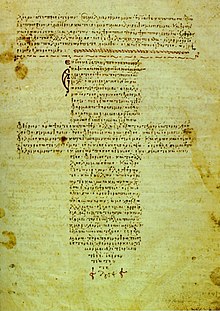
हिप्पोक्रेतसया ग्रन्थ (लातिन: Corpus Hippocraticum) प्राचीन ग्रीसय् प्राचीन ग्रीकया आयोनिक भाषिकाय् च्वयातःगु करिब ७०पू ग्रन्थतेगु मंका ख। थ्व दक्वं ग्रन्थ हिप्पोक्रेतसं हे च्वःगु खः कि मखु धैगु विषयय् छुं ठोस लिच्वः मलूनि,[४९] तर थ्व ग्रन्थत सम्भवतः वय्कःया विद्यार्थी व अनुयायीतेसं दयेकूगु जुइमा धैगु विश्वास दु। [५०] थ्व ग्रन्थय् दयाच्वंगु थीथी विषय, च्वयेगु पहः व लुयावःगु दयेकूगु तिथिया आधारय् विज्ञतेसं थ्व ग्रन्थत छम्ह जक्क मनूं च्वयातःगु मखु धैगु बिचा दयेकातःगु दु(Ermerinsया कथं थ्व ग्रन्थय् १९म्ह च्वमितेसं च्वःगु दु।[३०] थ्व ग्रन्थयात प्राचीन कालय् हिप्पोक्रेतसयात देछाना तल, व थुकिया शिक्षायात वय्कःया सिद्धान्तया रुपय् पालन यानातल; अतः, थ्व ग्रन्थ वय्कःया नामं नांजाल। थ्व ग्रन्थ कोसया सफूधूकुया ल्यनाच्वंगु ग्रन्थ वा ३ शदी इपूस अलेक्जेन्द्रियाय् संयोजित ग्रन्थ नं जूगु जुइफु। [३४][१३]
हिप्पोक्रेतस कर्पस (ग्रन्थ)य् पाठ्यसफू, लेक्चर (उपदेश), मालेज्या, थी-थी चिकित्साया विषयय् टीका व दार्शनिक च्वखँ क्रमहीन रुपय् संग्रहीत दु।[४९][५१] थ्व ग्रन्थ विशेषज्ञ निसें साधारण मनूतक्क, थीथी स्रोता व दर्शकतेगु निंतिं दयेकातःगु दु। नापं, थाय्थासय् थ्व ग्रन्थ प्रतिवादी रुपय् च्वयातःगु दु व थ्व ग्रन्थय् थाय्थासय् छगू हे विषयय् अन्तरविरोध नं दयाच्वंगु दु। [५२] थ्व ग्रन्थया उल्लेखनीय भागय् हिप्पोक्रेतिक सपथ; प्राग्ज्ञानया सफू (The Book of Prognostics); On Regimen in Acute Diseases; Aphorisms; On Airs, Waters and Places; Instruments of Reduction; On The Sacred Disease; आदि ला।[३०]
हिप्पोक्रेतसया सपथ
[सम्पादन]हिप्पोक्रेतसया सपथ वा हिप्पोक्रेतिक सपथ चिकित्सा ख्यलय् आचारनीतिया छगू प्रारम्भिक दस्ताबेज ख। थ्व सपथया श्रेय हिप्पोक्रेतसयात बीइगु या। सम्भवतः, थ्व सपथ हिप्पोक्रेतसया ग्रन्थया दकलय् नांजाःगु दस्ताबेज ख। वर्तमानय् थ्व सपथ थुकिया वास्तविक रुपय् मकाइगु जुसां थ्व सपथया आधारय् बुयावःगु समान सपथ व नियमतेसं चिकित्साय ख्यलय् बांलाःगु अभ्यास व नैतिकताया जग दयेकूगु दु। थ्व सपथया अंश वा थ्व सपथ थें न्यागु सपथ चिकित्सा शास्त्रया दिक्षान्तय् विद्यार्थीतेसं कायेगु या। [५३][१३]
Legacy
[सम्पादन]
Hippocrates is widely considered to be the "Father of Medicine".[५०] His contributions revolutionized the practice of medicine; but after his death the advancement stalled.[५४] So revered was Hippocrates that his teachings were largely taken as too great to be improved upon and no significant advancements of his methods were made for a long time.[१३][२७] The centuries after Hippocrates' death were marked as much by retrograde movement as by further advancement. For instance, "after the Hippocratic period, the practice of taking clinical case-histories died out...", according to Fielding Garrison.[५५]
After Hippocrates, the next significant physician was Galen, a Greek who lived from 129 to 200 AD. Galen perpetuated Hippocratic medicine, moving both forward and backward and side to side.[५६] In the Middle Ages, Arabs adopted Hippocratic methods.[५७] After the European Renaissance, Hippocratic methods were revived in Europe and even further expanded in the 19th century. Notable among those who employed Hippocrates' rigorous clinical techniques were Sydenham, Heberden, Charcot and Osler. Henri Huchard, a French physician, said that these revivals make up "the whole history of internal medicine".[५८]
Image
[सम्पादन]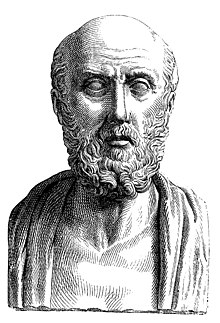
According to Aristotle's testimony, Hippocrates was known as "the Great Hippocrates".[५९] Concerning his disposition, Hippocrates was first portrayed as a "kind, dignified, old country doctor'" and later as "stern and forbidding".[१३] He is certainly considered wise, of very great intellect and especially as very practical. Francis Adams describes him as "strictly the physician of experience and common sense".[२०]
His image as the wise, old doctor is reinforced by busts of him, which wear large beards on a wrinkled face. Many physicians of the time wore their hair in the style of Jove and Asklepius. Accordingly, the busts of Hippocrates that we have could be only altered versions of portraits of these deities.[५४] Hippocrates and the beliefs that he embodied are considered medical ideals. Fielding Garrison, an authority on medical history, stated, "He is, above all, the exemplar of that flexible, critical, well-poised attitude of mind, ever on the lookout for sources of error, which is the very essence of the scientific spirit".[५८] "His figure... stands for all time as that of the ideal physician”, according to A Short History of Medicine, inspiring the medical profession since his death.[६०]
Legends
[सम्पादन]"Life is short, [the] art long, opportunity fleeting, experiment treacherous, judgment difficult."
Most stories of Hippocrates' life are likely to be untrue because of their inconsistency with historical evidence, and because similar or identical stories are told of other figures such as Avicenna and Socrates, suggesting a legendary origin. Even during his life, Hippocrates' renown was great, and stories of miraculous cures arose. For example, Hippocrates was supposed to have aided in the healing of Athenians during the Plague of Athens by lighting great fires as "disinfectants" and engaging in other treatments. There is a story of Hippocrates curing Perdiccas, a Macedonian king, of "love sickness". Neither of these accounts is corroborated by any historians and they are thus unlikely to have ever occurred.[६१][६२][६३]

Another legend concerns how Hippocrates rejected a formal request to visit the court of Artaxerxes, the King of Persia.[६५] The validity of this is accepted by ancient sources but denied by some modern ones, and is thus under contention.[६६] Another tale states that Democritus was supposed to be mad because he laughed at everything, and so he was sent to Hippocrates to be cured. Hippocrates diagnosed him as having a merely happy disposition. Democritus has since been called "the laughing philosopher".[६७]
Not all stories of Hippocrates portrayed him in a positive manner. In one legend, Hippocrates is said to have fled after setting fire to a healing temple in Greece. Soranus of Ephesus, the source of this story, names the temple as the one of Knidos. However centuries later, the Byzantine Greek grammarian John Tzetzes, writes that Hippocrates burned down his own temple, the Temple of Cos, speculating that he did it to maintain a monopoly of medical knowledge. This account is very much in conflict with traditional estimations of Hippocrates' personality. Other legends tell of his resurrection of Augustus's nephew; this feat was supposedly created by the erection of a statue of Hippocrates and the establishment of a professorship in his honor in Rome.[६३][६१][३६][६८]
वंशावली
[सम्पादन]हिप्पोक्रेतसया नांजाःगु वंशावलीइ वय्कःयात अबुया खलंः सीधा इस्क्लेपियस व मांया खलंः हेराकल्स नाप स्वानातःगु दु। [३०] Tzetzesया Chiliades कथं हिप्पोक्रेतस २या ahnentafel थ्व कथं दु:[६९]
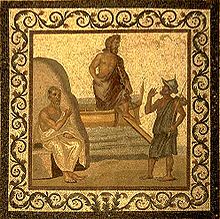
1. हिप्पोक्रेतस २. “चिकित्साया अबु”
2. हेराक्लिदेस् (Heraclides)
4. हिप्पोक्रेतस १ (Hippocrates I.)
8. ग्नोसिदिक्तस (Gnosidicus)
16. नेब्रस (Nebrus)
32. सोस्त्रातस् ३ (Sostratus III.)
64. थियोदोरस् २ (Theodorus II.)
128. सोस्त्रातस् २(Sostratus, II.)
256. थेदोरस (Thedorus)
512. क्लियोमित्तादेस् (Cleomyttades)
1024. क्रिसामिस् (Crisamis)
2048. दार्दानस (Dardanus)
4096. सोस्तातस् (Sostatus)
8192. हिप्पोलोकस (Hippolochus)
16384. पोदालिरियस (Podalirius)
32768. इस्क्लेपियस
Namesakes
[सम्पादन]Some clinical symptoms and signs have been named after Hippocrates as he is believed to be the first person to describe those. Hippocratic face is the change produced in the countenance by death, or long sickness, excessive evacuations, excessive hunger, and the like. Clubbing, a deformity of the fingers and fingernails, is also known as Hippocratic fingers. Hippocratic succussion is the internal splashing noise of hydropneumothorax or pyopneumothorax. Hippocratic bench (a device which uses tension to aid in setting bones) and Hippocratic cap-shaped bandage are two devices named after Hippocrates.[७०] Hippocratic Corpus and Hippocratic Oath are also his namesakes. The drink hypocras is also believed to be invented by Hippocrates. Risus sardonicus, a sustained spasming of the face muscles may also be termed the Hippocratic Smile.
In the modern age, a lunar crater has been named Hippocrates. The Hippocratic Museum, a museum on the Greek island of Kos is dedicated to him. The Hippocrates Project is a program of the New York University Medical Center to enhance education through use of technology. Project Hippocrates (an acronym of "HIgh PerfOrmance Computing for Robot-AssisTEd Surgery") is an effort of the Carnegie Mellon School of Computer Science and Shadyside Medical Center, "to develop advanced planning, simulation, and execution technologies for the next generation of computer-assisted surgical robots."[७१] Both the Canadian Hippocratic Registry and American Hippocratic Registry are organizations of physicians who uphold the principles of the original Hippocratic Oath as inviolable through changing social times.
टिप्पनी
[सम्पादन]- ↑ National Library of Medicine 2006
- ↑ Useful known and unknown views of the father of modern medicine, Hippocrates and his teacher Democritus., U.S. National Library of Medicine
- ↑ Hippocrates, Microsoft Encarta Online Encyclopedia 2006. Microsoft Corporation.
- ↑ Strong, W.F. & Cook, John A. (July 2007), "Reviving the Dead Greek Guys", Global Media Journal, Indian Edition, ISSN: 1550-7521, <http://www.manipal.edu/gmj/issues/jul07/strong.php>
- ↑ ५.० ५.१ ५.२ Garrison 1966, p. 92–93
- ↑ Nuland 1988, p. 5
- ↑ Garrison 1966, p. 96
- ↑ Nuland 1988, p. 4
- ↑ Britannica 2006
- ↑ Nuland 1988, p. 7
- ↑ Adams 1891, p. 19
- ↑ १२.० १२.१ १२.२ Margotta 1968, p. 66
- ↑ १३.० १३.१ १३.२ १३.३ १३.४ Martí-Ibáñez 1961, p. 86–87
- ↑ Plato 380 B.C.
- ↑ Plato 400 B.C.
- ↑ Adams 1891, p. 4
- ↑ Jones 1868, p. 11
- ↑ Nuland 1988, p. 8–9
- ↑ १९.० १९.१ १९.२ Garrison 1966, p. 93–94
- ↑ २०.० २०.१ Adams 1891, p. 15
- ↑ Margotta 1968, p. 67
- ↑ Leff & Leff 1956, p. 51
- ↑ Jones 1868, p. 12–13
- ↑ २४.० २४.१ Garrison 1966, p. 99 Cite error: Invalid
<ref>tag; name "garrison99" defined multiple times with different content - ↑ Boylan 2006
- ↑ Jones 1868, p. 46,48,59
- ↑ २७.० २७.१ Margotta 1968, p. 73 Cite error: Invalid
<ref>tag; name "margotta73" defined multiple times with different content - ↑ २८.० २८.१ Garrison 1966, p. 98
- ↑ Singer & Underwood 1962, p. 35
- ↑ ३०.० ३०.१ ३०.२ ३०.३ Encyclopedia Britannica 1911 Cite error: Invalid
<ref>tag; name "britannica" defined multiple times with different content - ↑ ३१.० ३१.१ ३१.२ Garrison 1966, p. 97 Cite error: Invalid
<ref>tag; name "garrison97" defined multiple times with different content - ↑ Adams 1891, p. 17
- ↑ Garrison 1966
- ↑ ३४.० ३४.१ Margotta 1968, p. 64
- ↑ Rutkow 1993, p. 24–25
- ↑ ३६.० ३६.१ Margotta 1968, p. 66
- ↑ Martí-Ibáñez 1961, p. 88
- ↑ Margotta 1968, p. 68
- ↑ Leff & Leff 1956, p. 45
- ↑ Schwartz, Richards & Goyal 2006
- ↑ Martí-Ibáñez 1961, p. 90
- ↑ ४२.० ४२.१ Major 1965
- ↑ ४३.० ४३.१ ४३.२ Jóhannsson 2005, p. 11
- ↑ ४४.० ४४.१ ४४.२ Jani 2005, p. 24–25
- ↑ Jóhannsson 2005, p. 12
- ↑ Mann 2002, p. 1, 173
- ↑ Shah 2002, p. 645
- ↑ NCEPOD 2004, p. 4
- ↑ ४९.० ४९.१ Singer & Underwood 1962, p. 27
- ↑ ५०.० ५०.१ Hanson 2006
- ↑ Rutkow, p. 23
- ↑ Singer & Underwood 1962, p. 28
- ↑ Jones 1868, p. 217
- ↑ ५४.० ५४.१ Garrison 1966, p. 100 Cite error: Invalid
<ref>tag; name "garrison100" defined multiple times with different content - ↑ Garrison 1966, p. 95
- ↑ Jones 1868, p. 35
- ↑ Leff & Leff 1956, p. 102
- ↑ ५८.० ५८.१ Garrison 1966, p. 94
- ↑ Jones 1868, p. 38
- ↑ Singer & Underwood 1962, p. 29
- ↑ ६१.० ६१.१ Adams 1891, p. 10–11
- ↑ Jones 1868, p. 37
- ↑ ६३.० ६३.१ Smith 1870, p. 483
- ↑ National Library of Medicine 2000
- ↑ Pinault 1992, p. 1
- ↑ Adams 1891, p. 12–13
- ↑ Internet Encyclopedia of Philosophy 2006
- ↑ Jones 1868, p. 24
- ↑ Adams 1891
- ↑ Fishchenko & Khimich 1986
- ↑ Project Hippocrates 1995
लिधंसा
[सम्पादन]![]() खंग्वसफू अर्थ विकिस्नरीय्
खंग्वसफू अर्थ विकिस्नरीय्
![]() सफू विकिसफूय्
सफू विकिसफूय्
![]() धापू विकिधापूय्
धापू विकिधापूय्
![]() श्रोत च्वसु विकिश्रोतय्
श्रोत च्वसु विकिश्रोतय्
![]() किपा व मध्यक विकिमंकाय्
किपा व मध्यक विकिमंकाय्
![]() बुखं विकिबुखंय्
बुखं विकिबुखंय्
![]() सीकिगु श्रोत विकिभर्सिटीय्
सीकिगु श्रोत विकिभर्सिटीय्
| Greek Wikisource has original text related to this article: |
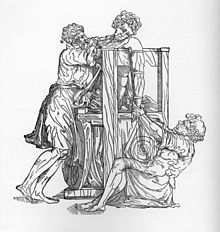
- Adams, Francis (1891), written at New York, The Genuine Works of Hippocrates, William Wood and Company.
- Boylan, Michael (2006), Hippocrates, Internet Encyclopedia of Philosophy, <http://www.iep.utm.edu/h/hippocra.htm>. Retrieved on September 28 2006.
- Britannica Concise Encyclopedia (2006), Soranus of Ephesus, Encyclopædia Britannica, Inc., <http://concise.britannica.com/ebc/article-9379121/Soranus-of-Ephesus>. Retrieved on December 17 2006.
- Encyclopedia Britannica (1911), HIPPOCRATES, vol. V13, Encyclopedia Britannica, Inc., 519, <http://encyclopedia.jrank.org/HIG_HOR/HIPPOCRATES.html>. Retrieved on October 14 2006.
- Garrison, Fielding H. (1966), written at Philadelphia, History of Medicine, W.B. Saunders Company.
- Fishchenko, AIa & SD Khimich (1986), "Modification of the Hippocratic cap-shaped bandage", Klin Khir 1 (72). PMID 3959439
- Hanson, Ann Ellis (2006), Hippocrates: The "Greek Miracle" in Medicine, Lee T. Pearcy, The Episcopal Academy, Merion, PA 19066, USA, <http://www.medicinaantiqua.org.uk/Medant/hippint.htm>. Retrieved on December 17 2006
- Hippocrates (2006), On the Sacred Disease, Internet Classics Archive: The University of Adelaide Library, <http://etext.library.adelaide.edu.au/mirror/classics.mit.edu/Hippocrates/sacred.html>. Retrieved on December 17 2006.
- Internet Encyclopedia of Philosophy (2006), Democritus, The University of Tennessee at Martin, <http://www.iep.utm.edu/d/democrit.htm>. Retrieved on December 17 2006.
- Jani, P.G. (2005), "Management of Haemorrhoids: A Personal Experience", East and Central African Journal of Surgery 10 (2): 24–28.
- Jóhannsson, Helgi Örn (2005), Haemorrhoids: Aspects of Symptoms and Results after Surgery, Uppsala University, ISBN 91-554-6399-1.
- Jones, W. H. S. (1868), Hippocrates Collected Works I, Cambridge Harvard University Press, <http://daedalus.umkc.edu/hippocrates/HippocratesLoeb1/page.ix.php>. Retrieved on September 28 2006.
- Leff, Samuel & Vera. Leff (1956), written at London and Southampton, From Witchcraft to World Health, Camelot Press Ltd..
- Mann, Charles V. (2002), Surgical Treatment of Haemorrhoids, Springer, ISBN 1852334967.
- Major, Ralph H. (1965), written at Springfield, Illinois, Classic Descriptions of Disease.
- Margotta, Roberto (1968), written at New York, The Story of Medicine, Golden Press.
- Martí-Ibáñez, Félix (1961), written at New York, A Prelude to Medical History, MD Publications, Inc., Library of Congress ID: 61-11617.
- National Library of Medicine (2006), Images from the History of Medicine, National Institutes of Health, <http://wwwihm.nlm.nih.gov/ihm/images/B/14/555.jpg>. Retrieved on December 17 2006.
- National Library of Medicine (2000), Objects of Art: Tree of Hippocrates, National Institutes of Health, <http://www.nlm.nih.gov/exhibition/tour/hippocrates.html>. Retrieved on December 17 2006.
- NCEPOD (2004), written at London, Scoping our practice, National Confidential Enquiry into Patient Outcome and Death, ISBN 0-9539249-3-3.
- Nuland, Sherwin B. (1988), Doctors, Knopf, ISBN 0394551303.
- Pinault, Jody Robin (1992), written at Köln, Hippocratic Lives and Legends, Brill Academic Publishers, ISBN 9004095748.
- Plato (2006), Protagoras, Internet Classics Archive: The University of Adelaide Library, <http://classics.mit.edu/Plato/protagoras.html>. Retrieved on December 17 2006.
- Project Hippocrates (1995), Project Hippocrates, Center for Medical Robotics and Computer Assisted Surgery, Carnegie Mellon School of Computer Science, <http://www.cs.cmu.edu/afs/cs/project/mrcas/www/hippocrates.html>. Retrieved on December 30 2006.
- Rutkow, Ira M. (1993), written at London and Southampton, Surgery: An Illustrated History, Elsevier Science Health Science div, ISBN 0-801-6-6078-5.
- Schwartz, Robert A.; Gregory M. Richards & Supriya Goyal (2006), Clubbing of the Nails, WebMD, <http://www.emedicine.com/derm/topic780.htm>. Retrieved on September 28 2006.
- Shah, J. (2002), written at London, "Endoscopy through the ages", BJU International (Academic Surgical Unit and Department of Urology, Imperial College School of Medicine, St. Mary's Hospital) 89 (7): 645–652, DOI 10.1046/j.1464-410X.2002.02726.x.
- Singer, Charles & E. Ashworth Underwood (1962), written at New York and Oxford, A Short History of Medicine, Oxford University Press, Library of Congress ID: 62-21080.
- Smith, William (1870), written at Boston, Dictionary of Greek and Roman Biography and Mythology, vol. 2, Little, Brown, and Company, <http://www.ancientlibrary.com/smith-bio/1590.html>. Retrieved on December 23 2006
Further reading
[सम्पादन]- Wesley D. Smith. Hippocrates. Free full-text article from Encyclopedia Britannica Online. Last accessed 19 Sep. 2008.
- Adams, Francis (translator) [1891] (1994), written at The Internet Classics Archive, Works by Hippocrates, Daniel C. Stevenson, Web Atomics © 1994–2000, <http://classics.mit.edu/Browse/browse-Hippocrates.html>.
- Jori, Alberto (1996), written at Bologna (Italy), Medicina e medici nell'antica Grecia. Saggio sul 'Perì téchnes' ippocratico, il Mulino.
- Kalopothakes, M. D. (1857), written at Philadelphia, An essay on Hippocrates, King and Baird Printers, <http://www.hti.umich.edu/cgi/t/text/pageviewer-idx?c=moa&cc=moa&idno=akk6471.0001.001&frm=frameset&view=image&seq=3>.
- Lopez, Francesco (2004), written at Cosenza (Italy), Il pensiero olistico di Ippocrate. Percorsi di ragionamento e testimonianze. Vol. I, Edizioni Pubblisfera.
- Pliny the Elder, Natural History: Book XXIX., translated by John Bostock. See original text in Perseus program.
- Smith, Wesley D. (1979), Hippocratic Tradition, Cornell Univ Pr, ISBN 0-8014-1209-9
| ||||||||||||||
| Persondata | |
|---|---|
| नां | Hippocrates of Kos |
| मेमेगु नां | Ἱπποκράτης (Greek) |
| चीहाकःगु विवरण | Physician |
| बुगु तिथि | ca. 460 BC |
| बुगु थाय् | Kos, Greece |
| मदुगु तिथि | ca. 370 BC |
| मदुगु थाय् | Kos, Greece |
| विकिमिडिया मंका य् थ्व विषय नाप स्वापु दुगु मिडिया दु: Hippocrates |
- Pages with reference errors
- Pages using duplicate arguments in template calls
- Featured articles
- इ पू ४६०य् बूगु
- 370 BC deaths
- Ancient Greek physicians
- Ancient Greek science writers
- Classical humanists
- Ancient Koans
- 5th-century BC Greek people
- 4th-century BC Greek people
- जीवनी
- Pages using PMID magic links
- Pages using ISBN magic links
